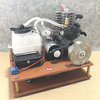I’m new to the forum, and very inexperienced in the field of electrical engineering (wishing I chose electrical engineering over biology). I am going on a wilderness fishing trip in northern Canada, and would like to take my fish finder/GPS. The problem is it pulls 1.41 amps (maximum brightness, etc.), and due to weight restrictions, I can only take 2 8 amp-hour batteries along. There is no electricity where I’m going, and I need a way to charge them. I have a small solar panel, but at peak efficiency (and no resistance loss) it would still charge too slowly to be of use. I’ve come up with the idea of a small hydro-electric generator that can be towed along/beside the boat instead. The only generators I’ve found that are suitable (and not outrageously expensive or heavy), produce 10 watts of power, but vary between 10v and 80v with the flow of water through the turbine. What parts would I need to assemble to be able to charge an 8 amp-hour 12v lead acid battery using this generator? I can work out the towing/generating assembly, but don’t know where to begin in the electronics department besides including a blocking diode. Also, would a second inline generator increase the charge rate when wired in parallel? or would it provide too much current and damage the battery? Any help will be much appreciated!
-
Categories
-
Platforms
-
Content



